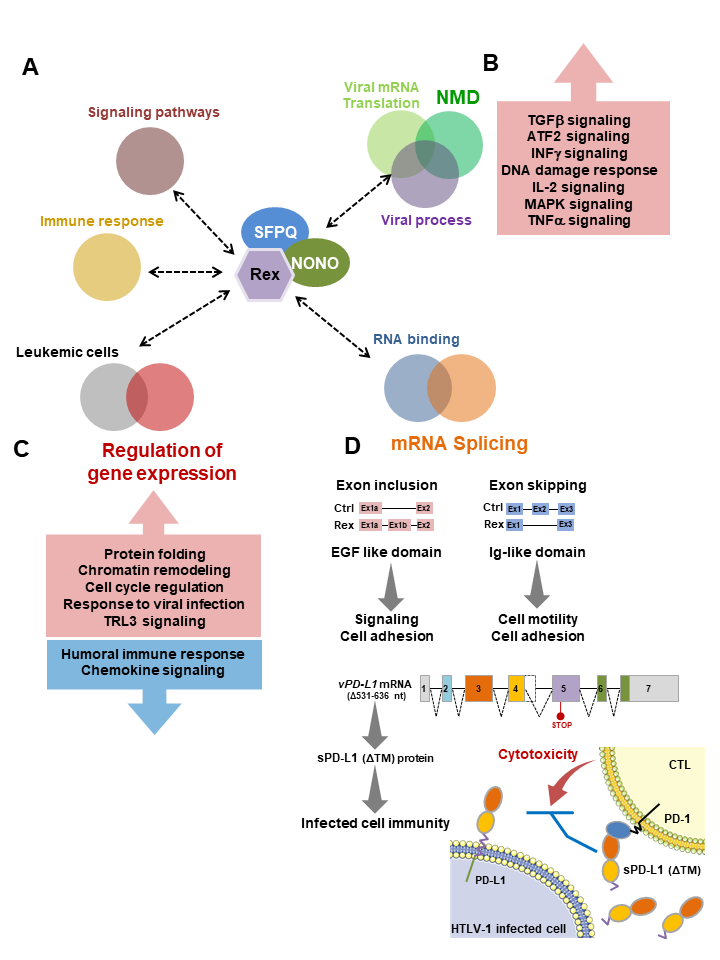メディカル情報生命専攻・病態医療科学分野(内丸・中野研究室)がHTLV-1ウイルスタンパク質Rexの宿主T細胞における新規機能を報告
- ニュース
Exploring New Functional Aspects of HTLV-1 RNA-Binding Protein Rex: How Does Rex Control Viral Replication?
Kazumi Nakano1*, Koichi Yokoyama1, Shuichi Shin1, Koki Uchida1, Kazuki Tsuji1, Marie Tanaka1,
Kaoru Uchimaru1, and Toshiki Watanabe2
- Department of Computational Biology and Medical Sciences, Graduate School of Frontier Sciences, The University of Tokyo, Tokyo 108-8639, Japan
- Department of Practical Management of Medical Information, Graduate School of Medicine, St. Marianna University, Kanagawa 216-8511, Japan
* Correspondence: nakanokz <span class="at-sign"><img src="/assets/images/at-sign.png" alt="@"></span> edu.k.u-tokyo.ac.jp
Viruses 2022, 14(2), 407. DOI: https://doi.org/10.3390/v14020407
<発表のポイント>
レトロウイルスであるHuman T-cell leukemia virus typeI (HTLV-1)は、ヒトT細胞に感染し、宿主細胞の転写・翻訳機構を利用してウイルス複製を行う。メディカル情報生命専攻の内丸教授と中野准教授の研究室では、HTLV-1のウイルス機能タンパク質のうち、特にウイルスRNAの安定化と運搬を担うRexが、宿主細胞内の環境をウイルス複製に有利な場に作り変える上で重要な働きをしていると考え、ヒトT細胞内でのRexの機能と影響を様々な方向から解析してきた。この度の論文では、本研究室の修士学生の研究成果を基盤に多角的な統合解析しを行い、これまで知られていなかったRexの新しい機能的局面と、宿主細胞への影響を明らかにした。
<Graphical Abstract>
New possibilities in the Rex functional pathways in HTLV-1-infected T cells. (A) Our results show that Rex interacts with proteins in human cells involved in gene expression, mRNA translation, NMD, viral process, RNA binding, mRNA splicing, immune response, and various signaling pathways. In particular, through NONO and SFPQ, Rex may influence various pathways in the cell. (B) The NMD repression by Rex results in the upregulation of genes involved in TGFb, ATF2, INFg, DNA damage response, IL-2, MAPK, and TNFα signaling whose expression levels are originally regulated by NMD. (C) Rex has been shown to upregulate genes encoding proteins involved in protein folding, chromatin remodeling, cell cycle regulation, response to viral infection, and TRL3 signaling, and suppress those involved in humoral immune response and chemokine signaling. (D) Rex influences the splicing pattern of many mRNAs. Exon inclusion tends to occur in mRNAs encoding EGF-like domain-containing proteins involved in signaling and cell adhesion, while mRNAs that are prone to exon skipping encode Ig-like domain-containing proteins involved in cell motility and cell adhesion. In particular, the amount of vPD-L1 (Δ531-636nt) mRNA was significantly elevated in CEM-Rex. Since this variant encodes a soluble PD-L1 (sPD-L1) lacking the transmembrane domain, early HTLV-1-infected T cells expressing Rex may release sPD-L1, which binds to PD-1 on CD8+ CTLs without cell-to-cell contact in the surrounding microenvironment and manipulates the immune response against infected cells.

